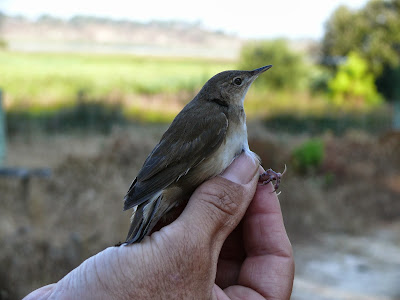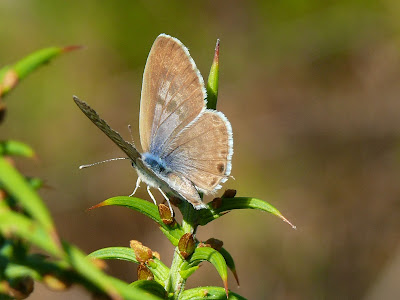The 2nd
saw the start of a 10 day ringing session at Lagoa de St Andre on the Atlantic
coast of Portugal about
140km south of Lisbon.
Ringing sessions have been undertaken in the area for over 20 years and most
years a group of UK ringers associated with the Maple Cross ringing group have
assisted during part of the autumn migration. As Denise is still working she
remained alas back in the UK.
No ringing
was done on the first day, just some additional net erection, with ringing
beginning in earnest on the Wednesday, together with some more net erection.
A couple of
sections of nets were erected for waders, but the lagoon is not tidal, although
spring high tides allow a little seepage in at high water but no more than the
odd inch or so of water, so there are no high tide wader movements and catches
are just reliant to random catch of birds moving around to feed or where
disturbed by raptors or the local farmer/cattle.
The second
day was the busiest with 114 birds, but after this the passage dropped and the
remaining days were moderate in respect of the days totals, especially if you
extract the Swallow or Yellow Wagtail roost totals. Also on the 11th
the bulk of the wader totals was due to the fact one of the group spent the
night out with the nets, on the first night after they were erected on the 7th,
where as most day they were only dropped around 4.30am
Evening
roosts remained low, with the only catch of any reasonable numbers were 36
Swallows on night of the 4th and 17 Yellow Wagtails on the night of 4th
and 9th, all processed the next day.
There was
an absence of Tree Sparrows the usually roost in the reed bed and boats catch
numbers. Reed Warblers dominated most
daily catches, with Willow Warbler numbers building up on the last 3 days.
Savi's Warbler
Redstart
Nightingale
Wryneck
Red Advant
Melodious Warbler
Short-toed Treecreeper
Lang's Short-tailed Blue
Scarce Swallowtail
Totals (new
birds only, excluded re-traps) for the period were:
|
3/9
|
4/9
|
5/9
|
6/9
|
7/9
|
8/9
|
9/9
|
10/9
|
11/9
|
Ringed Plover
|
|
|
|
|
|
1
|
|
|
|
Dunlin
|
|
|
|
|
|
11
|
2
|
2
|
1
|
Little Stint
|
|
|
|
|
|
1
|
|
|
|
Redshank
|
|
|
|
|
|
2
|
|
|
|
Green Sandpiper
|
|
|
|
|
|
1
|
|
|
|
Common Sandpiper
|
|
|
|
|
|
3
|
6
|
|
1
|
Barn Owl
|
|
|
|
|
|
|
1
|
|
|
Nightjar
|
|
1
|
|
|
|
|
|
|
1
|
Kingfisher
|
|
1
|
|
|
|
|
|
|
1
|
Hoopoe
|
|
|
1
|
|
|
|
|
|
|
Wryneck
|
|
1
|
|
|
|
1
|
|
|
|
Great Spotted Woodpecker
|
|
|
|
|
|
|
|
1
|
|
Swallow
|
|
3
|
36
|
6
|
|
1
|
|
7
|
|
Tree Pipit
|
|
|
2
|
1
|
2
|
|
3
|
|
|
Yellow Wagtail
|
|
|
17
|
5
|
9
|
6
|
2
|
17
|
|
Fan-tailed Warbler
|
|
|
|
|
|
|
|
|
|
Wren
|
|
2
|
|
|
|
|
|
|
|
Robin
|
|
|
|
1
|
|
1
|
|
|
|
Bluethroat
|
|
1
|
|
|
|
|
1
|
|
|
Nightingale
|
1
|
1
|
|
1
|
|
2
|
2
|
|
1
|
Redstart
|
1
|
|
|
|
|
|
|
|
|
Whinchat
|
1
|
1
|
1
|
1
|
|
|
|
|
|
Stonechat
|
1
|
|
1
|
2
|
1
|
|
|
|
|
Blackbird
|
|
2
|
2
|
5
|
1
|
1
|
|
1
|
1
|
Cetti’s Warbler
|
11
|
6
|
5
|
4
|
3
|
2
|
3
|
1
|
|
Fan-tailed Warbler
|
|
1
|
1
|
|
1
|
|
|
|
2
|
Savi’s Warbler
|
2
|
3
|
|
1
|
1
|
1
|
|
1
|
|
Grasshopper Warbler
|
1
|
3
|
1
|
2
|
1
|
|
4
|
1
|
3
|
Sedge Warbler
|
2
|
2
|
2
|
3
|
3
|
3
|
1
|
|
3
|
Reed Warbler
|
25
|
35
|
9
|
15
|
15
|
12
|
15
|
21
|
22
|
Melodious Warbler
|
1
|
1
|
|
2
|
3
|
2
|
1
|
1
|
|
Sardinian Warbler
|
1
|
5
|
1
|
|
3
|
1
|
1
|
1
|
|
Whitethroat
|
2
|
2
|
|
1
|
1
|
|
3
|
3
|
3
|
Garden Warbler
|
6
|
1
|
4
|
9
|
6
|
|
2
|
3
|
3
|
Blackcap
|
2
|
9
|
1
|
6
|
4
|
2
|
3
|
1
|
1
|
Chiff-chaff
|
|
5
|
|
3
|
2
|
1
|
3
|
3
|
2
|
Willow Warbler
|
14
|
15
|
9
|
4
|
11
|
11
|
23
|
25
|
27
|
Pied Flycatcher
|
2
|
4
|
1
|
1
|
2
|
2
|
3
|
1
|
|
Spotted Flycatcher
|
|
|
|
|
|
|
2
|
1
|
|
Blue Tit
|
|
4
|
2
|
3
|
1
|
1
|
|
5
|
2
|
Great Tit
|
|
1
|
1
|
|
|
2
|
1
|
|
|
Jay
|
|
|
|
|
1
|
|
|
|
|
Southern Grey Shrike
|
|
|
|
|
|
1
|
|
|
|
Greenfinch
|
|
|
|
|
|
|
|
|
|
Hoopoe
|
|
|
|
|
|
|
|
|
|
Short-toed Treecreeper
|
|
|
|
|
|
|
|
1
|
1
|
House Sparrow
|
|
|
2
|
|
|
4
|
|
1
|
|
Greenfinch
|
1
|
1
|
2
|
1
|
2
|
5
|
3
|
|
|
Goldfinch
|
|
|
1
|
1
|
|
|
|
3
|
2
|
Common Waxbill
|
|
2
|
1
|
|
|
|
2
|
|
|
Red Advant
|
|
1
|
|
|
|
|
|
|
|
Bluethroat
|
|
|
|
|
|
|
|
|
|
|
74
|
114
|
103
|
78
|
73
|
81
|
87
|
97
|
72
|


.jpg)


























